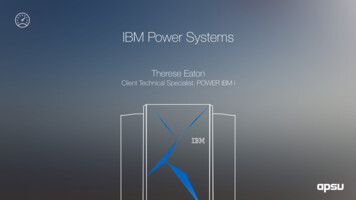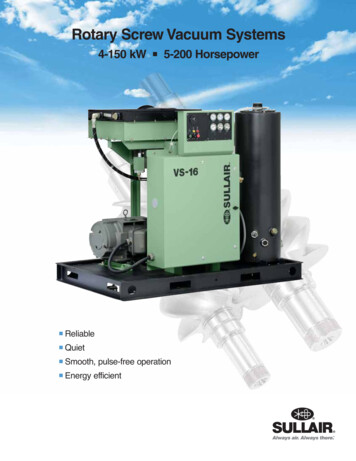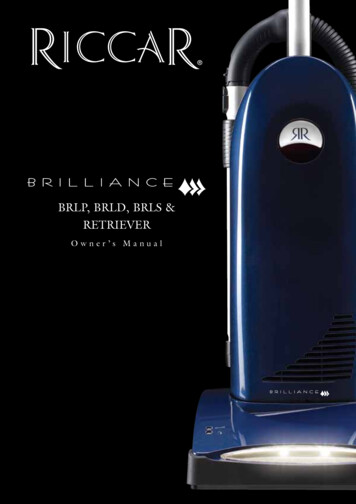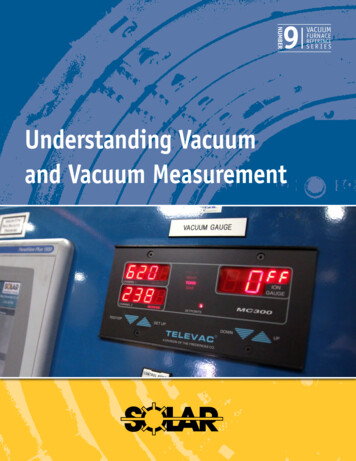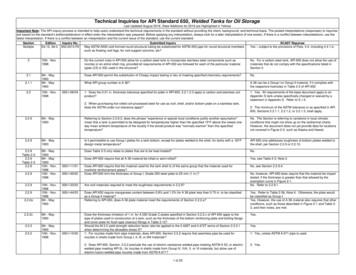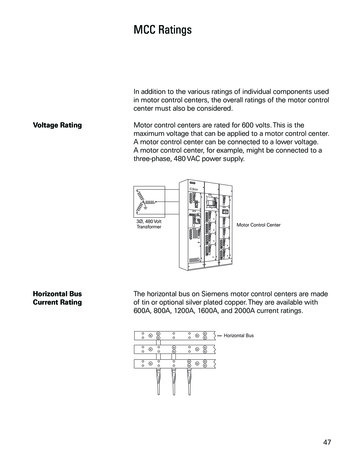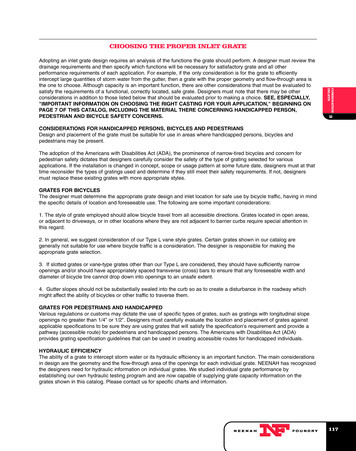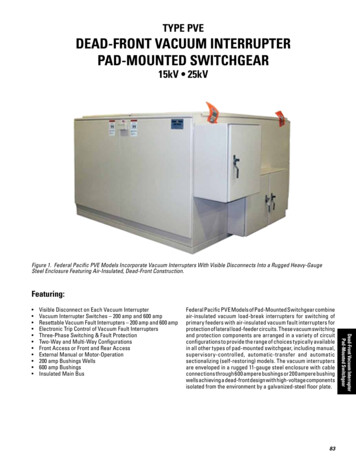
Transcription
TYPE PVEDEAD-FRONT VACUUM INTERRUPTERPAD-MOUNTED SWITCHGEAR15kV 25kVFigure 1. Federal Pacific PVE Models Incorporate Vacuum Interrupters With Visible Disconnects Into a Rugged Heavy-GaugeSteel Enclosure Featuring Air-Insulated, Dead-Front Construction.Featuring:Visible Disconnect on Each Vacuum InterrupterVacuum Interrupter Switches – 200 amp and 600 ampResettable Vacuum Fault Interrupters – 200 amp and 600 ampElectronic Trip Control of Vacuum Fault InterruptersThree-Phase Switching & Fault ProtectionTwo-Way and Multi-Way ConfigurationsFront Access or Front and Rear AccessExternal Manual or Motor-Operation200 amp Bushings Wells600 amp BushingsInsulated Main BusFederal Pacific PVE Models of Pad-Mounted Switchgear combineair-insulated vacuum load-break interrupters for switching ofprimary feeders with air-insulated vacuum fault interrupters forprotection of lateral load-feeder circuits. These vacuum switchingand protection components are arranged in a variety of circuitconfigurations to provide the range of choices typically availablein all other types of pad-mounted switchgear, including manual,supervisory-controlled, automatic-transfer and automaticsectionalizing (self-restoring) models. The vacuum interruptersare enveloped in a rugged 11-gauge steel enclosure with cableconnections through 600 ampere bushings or 200 ampere bushingwells achieving a dead-front design with high-voltage componentsisolated from the environment by a galvanized-steel floor plate.83Dead-Front Vacuum InterrupterPad-Mounted Switchgear
There is a choice of manual or electronically controlled trippingon all vacuum interrupters, which also feature an integral visibledisconnect, providing the optimum arrangements for distributionsystem switching, protection and isolation applications.Vacuum Interrupters With VisibleDisconnects, Both User Friendly andEnvironmentally FriendlyFederal Pacific's VIVD (vacuum interrupters with visible disconnect) technology is the ultimate in environmentally secureswitchgear incorporating air-insulated vacuum interrupters. Theenclosure controls moisture, restricts entry of airborne contaminants, prevents penetration by animals and the curious while alsoensuring security for operating personnel (by providing a visible gapafter the vacuum interrupter opens) and the public (by eliminatingexposure to hazardous materials or conditions).VIVD’s revolutionary configuration solves the dilemmas not previously addressed by all other insulating mediums whether liquidfilled, gas-filled or solid-dielectric equipment namely, providingan environmentally friendly insulating and isolating medium.Liquid Insulation MediumsFigure 2. Federal Pacific’s 15kV, 600 Ampere MagneticallyActuated Vacuum Fault Interrupter Switch For Use With aSelf-Powered Relay Includes An Integral Visible Disconnect.Disconnect Shown Closed.Dead-Front Vacuum InterrupterPad-Mounted SwitchgearFederal Pacific is the design innovator that has continued to developand introduce superior medium-voltage switching and protectionproducts for the electric power industry for over 50 years. Alwayspursuing functional configurations with operational considerationsparamount, Federal Pacific is the industry leader that providesessential and exceptional features that keep competitors focusedand following its lead.Liquid dielectrics, whether-or-not they are biodegradable, have thepropensity to ignite under the influence of an electrical arc, whichreaches many thousands of degrees, creating an environmental andpersonnel hazard. In addition, liquid dielectrics consume resourcesthat are best saved for use in other energy and food applications.Furthermore, the insulating property of liquid dielectric must beclosely monitored to verify its quality and integrity and freedomfrom contamination by moisture and particulate material.Liquid dielectrics are very heavy materials and, therefore, requirehigh-capacity moving and handling equipment as well as substantially reinforced sub-structures on which to place them forinstallation or other mountings.Gas (SF6) Insulation MediumsGas-filled units nearly always utilize sulphur hexaflouride (SF6),which is identified as the worst green-house gas that threatens theglobal environment. Equally detrimental as a severe health hazard,SF6 gas will form carcinogenic materials when it is exposed to anelectrical arc. The high temperature of the electrical arc breaksdown the SF6 gas into products that have been proven to causecancer. The quality and quantity of SF6 gas within an interruptingchamber must be closely monitored and assured prior to performingany switching operation to avoid an eventful failure if insufficientgas is present or if it has become contaminated by moisture.Equipment utilizing SF6 gas cannot be sealed to completely eliminate leakage of the gas, consequently refilling is inevitable andfacility to remove and refill must be provided. Another concernand consideration is that reclamation equipment for housing SF6when repair or replacement is necessary is expensive and cumbersome. The Federal government has implemented ever increasingstringent reporting requirements on the use and emissions of SF6gas into the environment. Therefore, it is evident that the handlingand disposal of equipment containing SF6 will gain increasingscrutiny in the future.Figure 3. Federal Pacific’s 15kV, 600-Ampere Vacuum FaultInterrupter With Visible Disconnect For Use With OvercurrentRelays That Require External Control Power. DisconnectShown Closed.84
Solid-Dielectric Mediumsopened until after the vacuum interrupter has opened to interruptthe circuit. Furthermore, similar interlocking makes certain thatUnits that incorporate solid materials, such as rubber and epoxies, the vacuum interrupter cannot be closed until after the visibleas the insulating medium also present detrimental impact on the disconnect is closed.environment and may have a hidden potential to develop disruptivefailures. These compounds, rubber and epoxies, do not biodegrade Eliminating reliance on liquid (oil), gas (sulphur hexaflouride —in any reasonable time frame and are therefore materials that are SF6), and solid materials (rubber and epoxy) as encapsulatingharmful to the environment. Furthermore, these compounds require and insulating materials, and utilizing air as a dielectric mediumconsiderable energy to manufacture, consuming resources that in a controlled environment, VIVD Technology Switchgear is theare better utilized for other applications.leading-edge green technology revolutionizing distribution systemreliability while providing unsurpassed operational flexibility.Solid-dielectric materials typically are employed to encapsulatevacuum interrupters. But, these encapsulated interrupters have not VIVD Technology Switchgear . . . Enhancesbeen successfully integrated with a visible disconnect that doesnot compromise the operational security and ease of operation Reliability with Air-Insulated Vacuumafforded by insulation in air. Also, the additional space required to Interruptersadd a visible gap may compromise the smaller footprint afforded With over fifty years of design, development and manufacturingby the solid-dielectric design.experience in the electric power industry, Federal Pacific brings itsPVE line of switchgear products and components to enhance theAir-Insulated Mediumssecurity and reliability of underground distribution systems. The Air as an insulating medium is replenishable and self renewing and major components of Federal Pacific’s VIVD technology systemthereby avoids the inherent hazards associated with every other include an air-insulated load-break vacuum interrupter switchinsulating medium. Air is a naturally occurring compound that does for switching of main-primary feeders, air-insulated vacuum faultnot deplete or consume other energy resources in its production. interrupters for switching and fault protection on distribution lateralAn air-insulated electrical component does not require a refill load-feeder circuits, visible disconnects on all vacuum interruptersvalve, a pressure indicator or a volume level gauge. Air involved for confirming circuit isolation, trip-free operating mechanismsin an electrical arc does not develop any hazardous properties. for instantaneous circuit interruption if closed onto a fault and anAir is the most economical insulating medium. Air is the ultimate electronic sensing package for reliable tripping fault interruptersgreen-energy technology for switching and protection on electrical in response to overcurrent conditions.power distribution circuits.Since air is an environmentally neutral medium, it is successfullyused in the widest range of applications to provide insulatingproperties that are fully effective when combined with appropriatedesign controls. In-air insulation, manifested in the VIVD technology, provides the visible open gap not offered by most othervarieties of switchgear with vacuum interrupter technology. Eachgroup-operated vacuum interrupter is integrated with a three-pole,group-operated visible disconnect. The integrated arrangement hasthe vacuum interrupter mechanically and electrically interlockedwith the visible disconnect such that the disconnect cannot beVacuum InterruptersSince its first use in the 1920’s, vacuum technology has becomethe interrupting medium of choice.Vacuum circuit breakers have nearly 60 years of service in theseverest of environments. Vacuum interrupters are efficient with avery low failure rate and are maintenance free. Vacuum technologyissues no damaging ozone-depleting emissions. Vacuum interrupters contain all interrupting materials preventing any ionized gasesfrom causing flashover of insulators to ground or phase-to-phase.Dead-Front Vacuum InterrupterPad-Mounted SwitchgearFigure 4. Federal Pacific’s 15kV Manually-Operated VacuumInterrupter With Visible Disconnect. Shown With DisconnectOpen.Figure 5. Federal Pacific’s 27kV Vacuum Fault Interrupter WithMotor Operator.85
Vacuum interrupters separate a set of contacts within an evacuated chamber. Vacuum interrupters are extremely compact andthe circuit interruption process is virtually silent, with any noiseassociated with the operating mechanism. All of the materials usedare benign to the environment. The vacuum chamber is of a ceramicmaterial. Metals of various types comprise the contacts, shields andterminals. The interrupting capability of vacuum interrupters canexceed the mechanical capability of the operating mechanisms.Contact technology enhancements have made vacuum interruptersthe dependable preferred methodology for circuit interruption. Withvacuum interrupters there are no gases discharged to contaminateadjacent components or the dielectric. Vacuum interrupters canbe mechanically reset easily so there are no components to bereplaced after an operation. Vacuum interrupters are capableof an exceptionally large number of mechanical and electricaloperations before service may be necessary, if ever.Vacuum Fault Interruptersthat may occur with single-phase operation of lightly loaded circuits. In addition, the superior vacuum dielectric in the interruptermakes the possibility of restrikes and flashovers negligible. Anoperating mechanism combined with a reliable vacuum load-breakinterrupter insures the durability of the switching device over theanticipated life of the switchgear.The vacuum fault interrupters are high-precision hermeticallysealed contact systems that provide an effective, efficient meansto interrupt rated fault currents. This capability has been proven intesting to ANSI/IEEE C37.60 which requires 116 fault interruptingoperations over various percentages of the symmetrical shortcircuit rating. All vacuum fault interrupters include an integralvisible disconnect and an independent wear indicator on eachphase, plus each phase has the capability to be independentlyadjusted to achieve proper contact pressure.The exceptional switching and fault-closing capabilities of vacuumfault interrupters makes “fault hunting” more practical than everbefore. And, the trip-free functionality of vacuum fault interruptersallows interrupters to immediately open when closed on a fault.That trip-free capability of vacuum fault interrupters minimizesexposure to excessive overcurrents and heating that shortenlife-cycle operations due to insulation breakdown.Dead-Front Vacuum InterrupterPad-Mounted SwitchgearFederal Pacific’s 15kV vacuum fault interrupters are availablewith continuous current ratings to 1200 amperes and short-circuitinterrupting ratings to 18,000 amperes rms symmetrical, 28,800amperes rms asymmetrical. And, Federal Pacific’s 25kV vacuumfault interrupters are available with continuous current ratings to600 amperes and short-circuit interrupting ratings to 12,500 amperes The vacuum interrupters are high-precision hermetically sealedcontact systems that provide an effective, efficient means torms symmetrical, 20,000 amperes rms asymmetrical.interrupt load currents. These interrupters have the capability toFederal Pacific combines three (3) vacuum interrupters with an interrupt the rated load current for up to 10,000 operations.operating mechanism to achieve three-phase load-break operationand avoid single phasing. With three-phase operation, vacuuminterrupters virtually eliminate the possibility of ferro-resonance86
Visible DisconnectsBushings and Bushing WellsPersonal security is an important consideration in the developmentof all switches and fault interrupters. One of the primary advantagesair-insulated equipment has over liquid-filled, SF6-filled and soliddielectric equipment is the ability to provide a superior integralvisible disconnect. Air-insulated switchgear avoids the necessityto compromise the visible disconnects. Liquid-filled designs eitherutilize a semaphore signal or an obscure arrangement viewedthrough a distorting liquid. Similarly, SF6-filled designs either utilizea semaphore or a less visible disconnect arrangement, which ifin the gas medium has the potential to leak and create hazardousmaterials when an event occurs across the open gap – a realpossibility for units that are known to leak and lose dielectric. Aviable visible disconnect has not been developed for solid-dielectricdesigns, which if not imbedded in the dielectric material will eitherbe expensive or compromise the advantage of solid dielectric if itremains in an air environment.Insulators of cycloaliphatic epoxy (CAE) polymers have beenused in the power industry for over fifty years and have provenfield experience globally in both indoor and outdoor applications.These polymers are light weight, homogeneous and readily moldedby the automatic pressure gelation (APG) process in both simpleand complex contours. The formulation is balanced for high voltage, high strength, non-tracking, self-scouring, non-weatheringapplications in extremes of high temperature and sub-zero cold.Federal Pacific’s bushings and bushing wells are of cycloaliphaticepoxy and meet all the criteria set forth in ANSI/IEEE 386, whichestablishes ratings and design interface to accommodate industrystandard insulated separable elbow connectors. To ensure thelong-term survivability of Federal Pacific bushings and bushingwells, every individual unit is x-rayed in a 360 top-to-bottomexamination to insure the integrity of the insulation. All bushingsand bushing wells feature high conductivity copper rod contactsand include removable silver-plated copper studs. In addition,bushings and bushing wells all carry an engraved serial numberfor quality audit if the need should ever arise and are traceableto the particular switchgear assembly.Figure 8. Federal Pacific’s Visible Disconnect (shown open) isavailable on all Federal Pacific Vacuum Interrupter Switchesand Vacuum Fault Interrupters.Dead-Front Vacuum InterrupterPad-Mounted SwitchgearFigure 9. Federal Pacific cycloaliphatic bushings and bushingwells have all copper conductors and silver-plated removablestuds. Semi-conductive coating isolate bushings and dustcovers protect high-voltage interfaces.87
Overcurrent ProtectionMotor OperatorsFederal Pacific’s vacuum fault interrupters response to overcur- Federal Pacific vacuum interrupters can be optionally equippedrents occuring on load-feeder circuits is controlled by either a with integral motor operators. When motor operated, the unitsself-powered relay (see Figure 10) that energizes a magnetic latch to trip are suitable for integration with additional appropriate controlthe vacuum fault interrupter or by an SEL-501 Dual Universal OCR (see systems for application in automatic-source-transfer, automaticFigure 11) or similar overcurrent relay (OCR).sectionalizing, remote-supervisory-control and shut-trip schemes.The self-powered relay in combination with the magnetic latch isutilized when vacuum fault interrupter operation is to be performedmanually using the manual operating handle mounted on the sideof the pad-mounted switchgear (or the manual trip-open buttonon the faceplate). Power for the relay is generated by the currenttransformers used for sensing the overcurrent.Federal Pacific motor operators are installed directly on the frameof the vacuum interrupter. The integrated compact arrangementof motor operators with vacuum interrupters means that very littleadditional space is required for applications requiring automation.Optional controls are also available to permit motor operation andall tripping functions to be performed from a local but isolatedlocation. By operating the unit by means of such a local, portablecontrol station will eliminate concerns over exposure to arc-flashhazards.1Figure 11. Overcurrent Protection is provided using The SEL-501Dual Universal OCR (see above left). Each OCR relay control canhandle two vacuum fault interrupters. A UPS (at bottom in above leftphoto) is included to make certain control power is always availablefor operation of the relay to trip the vacuum fault interrupter inresponse to a fault a UPS is included. A current transformer (seeabove right) is used to sense the overcurrent condition and providethat input to the SEL-501 relay.23Dead-Front Vacuum InterrupterPad-Mounted SwitchgearFigure 10. The self-powered relay components include (1) the relaythat provides all the settings and controls necessary to initiate vacuumcircuit-breaker operations based on the programmed parameters,(2) the magnetic actuator pictured that provides mechanical tripactuation of the vacuum circuit-breaker mechanism and (3) thecurrent-sensing transformer that provides sensing and power input tothe relay and trip circuit.The SEL-501 relay (see Figure 11) requires that control power always be available and is used when the vacuum fault interrupteris to be motor-operated and also requires a UPS so that operationscan be performed even when control power is lost. The relay andmotor will then be powered by a control-power source, typicallya voltage transformer. The SEL-501 relay provides overcurrentresponse for two vacuum fault interrupters in a single compactpackage. The relay is readily programmed to provide the specificrelay curve that is desired for the particular application.Current transformers provide overcurrent sensing as input to therelay. Reliability of the current transformers has been demonstratedover many years of service in all types of environments from thevery hot to the very cold.Federal Pacific vacuum fault interrupters are trip free. Whenclosed on a fault, the vacuum fault interrupter will immediatelyopen to clear the circuit.88Figure 12. Motor Operators Can Be Added To All Federal PacificVacuum Interrupters As Pictured At The Bottom Right On The15Kv Vacuum Fault Interrupter Above.
5436789210 11112131415Figure 13. Enclosure Exterior of Federal Pacific PVE Vacuum Interrupter Pad-Mounted Switchgear.1.2.3.4.5.6.7.8.11-Gauge Steel DoorsHazard-Alerting Warning Signs On ExteriorHinged, Stainless-Steel Door LockboxOne-Piece, Cross-Kinked 11-Gauge Steel RoofInsulating No-Drip Compound On Underside Of RoofSilk-Screened, Aluminum Stamped Nameplate11-Gauge Steel Welded EnclosureControl Compartments Sealed To Enclosure29.10.11.12.13.14.15.43Drip-Shield Over Control CompartmentsGalvanized-Steel Lifting BracketsClosed-Cell Cushions Isolate Enclosure From Lifting BracketVacuum-Interrupter Electronic-Control CompartmentVacuum-Interrupter Manual-Control CompartmentsStainless-Steel Handles On Control CompartmentsClosed-Cell Gasket At Bottom Isolates Enclosure From MountingSurface567819101119171612 131514Figure 14. Incoming Termination Compartments of Vacuum Load-Break Switched Ways.1.2.3.4.5.6.7.8.9.10.11.Hazard-Alerting Danger Signs On InteriorStainless-Steel WindbraceThree (3) Stainless-Steel Hinges & Hinge Pins Per Enclosure DoorBumper Gasket Cushions Door Interface, Prevents Metal-To-MetalContactCenter Steel Divider Isolates Termination CompartmentsClosed-Cell Gasket Seals Roof To Equipment-Mounting PanelPhase Identification LabelsCompartment Identification Labels600 Ampere Cycloaliphatic Epoxy Bushings With All-CopperConductor On Stainless-Steel Clamping BracketRemovable Silver-Plated All-Copper Stud On All Bushings WithRed Protective Dust CoversStainless-Steel Parking Stand For Each Bushing12.Cross-Kinked, Galvanized-Steel Floor Plate Isolates VacuumInterrupters And Bus13. Stainless-Steel Screened 1” Vent In Each Corner Of Floor PlateAllows Any High Ground Water or Flooding To Drain Out14. Formed-Steel Equipment-Mounting Panels Isolate High-VoltageComponents From Termination Compartments15. Wide-View Clear Polycarbonate Window For Viewing VisibleDisconnect On Vacuum Load-Break Switches16. Vacuum Load-Break Interrupter Switches17. Stainless-Steel Door-Latch Pins18. Visible Disconnects For Vacuum Load-Break InterrupterSwitches19. Continuous Ground Bus In Vacuum-Switch Termination Compartments89Dead-Front Vacuum InterrupterPad-Mounted Switchgear18
23451017617981613 14151211Figure 15. Load-Feeder Termination Compartments of Vacuum Fault-Interrupter Protected Ways.1.2.3.4.5.Dead-Front Vacuum InterrupterPad-Mounted Switchgear6.7.8.9.10.90Compartments Provide Access To Manual-Operating Handles OfVacuum InterruptersFused-Voltage Transformers For Sensing And Control Power ForRelayed Vacuum Fault InterruptersViewing Window Provides Visibility And Access To Fused-VoltageTransformers600 Ampere Bushings For Fault InterruptersStainless-Steel Mounting Plate And Parking Stand For Each BushingViewing Windows For Fault InterruptersVacuum Fault InterruptersVisible Disconnect For Vacuum Fault InterruptersSelf-Latching And Resetting Three-Point Door LatchesPenta-Head Actuated Self-Latching Door Operating Mechanism11.12.13.14.15.16.17.Undercoating Is Applied In Door-Flange Channel, Which IncludesDrain Holes, To Provide Protection Against Accumulation of Contamination And MoistureStorage PocketCurrent Transformers For Overcurrent Sensing On Vacuum FaultInterrupters (Optional Window-Type CTs Shown)Optional Split-Core Current Transformers For Overcurrent SensingContinuous Copper Ground Bus Across Door Opening Of LoadFeeder Termination CompartmentsOptional 200 Ampere Bushing Wells To Replace 600 Ampere BushingsOptional Mounting Provisions For Fault Indicators
342111015126Figure 16. Faceplate of Vacuum Fault Interrupter.1. Faceplate Is Silk Screened for Permanent Labeling(See Figure 13)2. Visible-Disconnect Manual-Operating Handle3. Vacuum Fault-Interrupter Manual-Operating Handle4. Manual-Trip Open Operating Button5. Vacuum Fault-Interrupter Open/Closed PositionIndicators6. Padlock Tab for Visible-Disconnect ManualOperating Handle7. Overcurrent Relay8. Optional Motor Operator9. Isolating Fiberglass Barrier10. Vacuum Fault Interrupter11. Insulated Phase Supports12. Contact-Pressure Counter-Weight13. Steel Mounting Frame14. Undervoltage Relay15. Shunt-Trip RelayFigure 17. 15kV Vacuum Fault Interrupter WithOptional Motor Operator.9137148Dead-Front Vacuum InterrupterPad-Mounted Switchgear15Figure 18. 27kV Vacuum Fault Interrupter With OptionalMotor Operator.91
1.2.3.4.5.6.7.8.Load-Break Vacuum InterrupterOutgoing (Load-Side) ContactsContact Pressure CounterweightVisible-Disconnect Operating LinkVisible-Disconnect Operating ShaftStationary Contact For Visible DisconnectDisconnect Blade ClosedDisconnect Blade Open2135Figure 19. Vacuum Load-Break Interrupter Switch674Dead-Front Vacuum InterrupterPad-Mounted SwitchgearFigure 20. Integral Visible Disconnect – Disconnect Closed.8Figure 21. Integral Visible Disconnect — Disconnects Open.92
1. Fully Gasketed Door Opening on Low-Voltage ControlCompartments2. Stainless-Steel Hinges and Hinge Pins on Control Compartment Doors3. Self-Latching Wind Brace4. Stainless-Steel Hinges and Hinge Pins on Relay Panel5. Hinged Relay Panel Allows Easy Access To Internal Wiringand Components6. Captive Wing Nut Secures Relay Panel Closed7. Elevated Component Mounting Plate Eliminates any Contactwith Moisture8. Heavy 11-gauge steel enclosure9. Heater for Compartment Interior (not visible)10. Internal Thermostat (not visible)11. Internal Humidistat (not visible)1268759431011Figure 22. Features of Low-Voltage Enclosure for Relay andControls. Configuration varies depending on specified requirementsand relay used (shown with SEL-501 relay).FeederLocal/RemoteSEL-501 Dual Universal OCRFeeder Open/CloseBattery TestInternal/ExternalPowerDead-Front Vacuum InterrupterPad-Mounted SwitchgearIncoming Open/CloseLamp Test120V AC ReceptacleTest SwitchesFeeder TripEnabled/DisabledFigure 23. Relay and Control Compartment Component Identifications. Configuration varies depending onspecified requirements and relay used (shown with SEL-501 relay).93
SPECIFICATIONSAMPERESVacuum Fault InterrupterVacuum Load Interrupter SwitchLightningMaximumImpulseApplicable Voltage Frequency, witching Switching ,50060012,50012,50012,500 Units rated 200 amperes are furnished with 200-ampere bushing wells for connection of 200-ampere loadbreak inserts and separable insulated connectors. Vacuum Fault Interrupters and Vacuum Load Interrupters are rated 600 amperes.* If integrated with relay control.Dead-Front Vacuum InterrupterPad-Mounted SwitchgearNOTE: For higher continuous current or fault current capabilities, contact the factory.94
Gas (SF6) Insulation Mediums Gas-filled units nearly always utilize sulphur hexaflouride (SF6), which is identified as the worst green-house gas that threatens the global environment. Equally detrimental as a severe health hazard, . down the SF6 gas into products that have been proven
